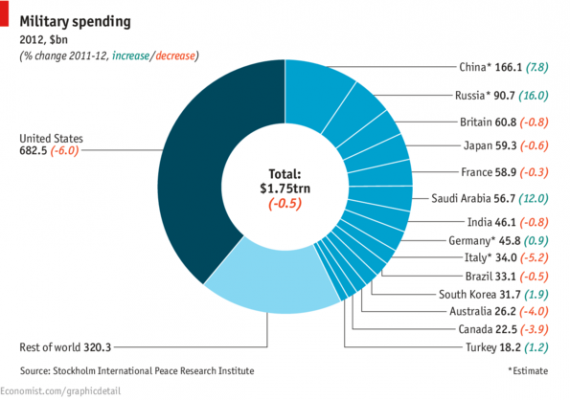Chart Of The Day: Yes, We Can Afford To Cut Defense Spending
Ezra Klein passes along this chart:
And comments:
This graph, which comes from the Economist’s Daily Chart blog, includes our war spending in our overall defense budget. Defense wonks can argue whether that’s proper. I think it is. But let’s rip out some of that spending. Even if we cut current defense expenditures by 30 percent, all at once, we’d still be spending more than the next five biggest spenders combined.
Even that understates our advantage, though, as at least three of those spenders — Britain, France, and Japan — are firm allies, and any country considering a serious challenge to U.S. or western interests will have to properly consider their defense budget not just in terms of our defense budget, but in terms of our defense budget plus the defense systems of those who will probably be on our side
None of this is surprising, of course, as it’s merely an update version of charts we’ve seen in the past comparing military spending among different nations. It’s a point that bears repeating in the fact of continued claims from the defense lobby and conservatives that we cannot afford to trust a penny of the Pentagon budget.







Unfortunately, that chart doesn’t illustrate the title contention—that we can afford to cut defense spending. What it does illustrate handily is that the U. S. military is undertaking too much.
Don’t get me wrong. I’ve supported cuts more drastic than most are proposing for years. I think that cutting our military spending in half would be a nice, round figure.
However, first things first. Let’s cut the missions we’re undertaking before we start trying to figure out how much we need to spend executing them.
@Dave Schuler:
As I’ve said before, hand in hand with the issue of cutting Pentagon spending is a rethinking of what it is we want the military to do, and how committed we want to be to having a military presence in other nations that essentially acts as a defense umbrella for them at no cost to them.
@Dave Schuler:
Surely we fund for far more missions than we actually undertake. The justification after all is world wars we only see as low probability outcomes.
@john personna:
As I used the term “mission” includes the capacity to fight two major wars in two different places at the same time.
This economic study by the Aerospace Industry Association (pdf) might be worth looking over. Appears for all that spending we get about 3.53 million jobs.
@Dave Schuler:
OK, but what I’m saying is that preparedness creeps to missions no one really expects or supports.
I’m sure when Congress is making the Army accept more tanks than they want, they have a “mission” invented for that moment, and then discarded. It isn’t a real mission that we need to rethink.
Or put another way, we can’t move from one well thought out set of mission requirements to another, because we don’t start with a well thought out set of mission requirements. We have rationalizations more than missions, supporting our massive military spending.
(The long history of Congress overloading the various branches of the military with more X than they want shows that this isn’t JUST a mission problem.)
BTW, a very interesting discussion has broken out on the economic forums on spending in general:
‘How Much Unemployment Was Caused by Reinhart and Rogoff’s Arithmetic Mistake?’
These comparisons always bother me in that China can probably support an infantry division or a fighter squadron or a ship for a fraction of what it costs us. Quality being a different issue. That said, note that of the fourteen named countries other than the US, at least ten would have to be counted as allies.
Definitely we can afford to cut defense spending. And not merely in the spaced out parlance of D.C. We can spend less money on defense. We’re not going to be engaging in a land war in China. We don’t need to have even further air superiority over enemies and frenemies who if we did nothing for 30 years still couldn’t challenge us in the skies. The South Koreans can pay lock stop and barrel for the 2ID. There still are a lot of bases out there we don’t need.
That’s where the GOP and elements of the right go off the rails.
Below is where the left goes off the rails:
We also can afford to cut the following: DOJ, DOE, the other DOE, SEC, FEC, DOL, NLRB, EEOC, EPA, DOI, HUD, AFDC, Medicaid, NEA, DOT, OSHA, DOC. Etc.
Printing and spending public money is like mainlining heroin. For a while it feels real good. But it never ends well.
I realize and understand the need for cuts, prudent spending, and better planning. We should not get involved any where without a plan to win. The military needs to reform and change their contracting and purchasing procedures. I read a report a while back that they pay $300 for a screwdriver, $450 for s hammer, and $1200 for a coffee maker!! That needs to change.
I am also concerned about cuts to the naval fleet and our forces in Germany. We must have a navy that is second to none. We don’t need for Russia to get an impression that we are somehow letting up or getting weak. We have gone through this too many times and paid the price (Berlin, Cuba).
@Tsar Nicholas: What I still want to see from you “drown government in a bathtub” guys is WHAT you want to stop spending money on. I don’t even care that it will only total 0.001% of the outlay. Give me the list!
@Tyrell:
We are no longer in the cold war, so the idea that Russia is going to take advantage of perceived weakness is not a strong argument.
I agree that we need to have a strong Navy to guarantee freedom of the oceans, but I’m not sure how reducing our presence in Germany prevents that. Or are we keeping them there to prevent the communists from retaking East Germany?
These comparisons are a bit simplistic and don’t really represent apples-apples comparisons. Just as one example, the US Department of Defense spends Germany’s entire military budget just on health care for military service members and dependents. Most other countries with national health systems don’t have these high costs.
Still, the narrative implied by the chart is basically accurate – that the US spends way more than anyone else on defense when one compares aggregate numbers. I think a more useful comparison is defense expenditures per soldier. Here’s how that breaks out for 2011:
US including war costs: $475,000
US baseline (without war costs): $310,000
European Average: $130,000
UK: $285,000
Turkey: $23,000
China: $28,000
Japan: $238,000
Secondly, Europe, for example, spends about 55% of their defense budgets on personnel costs, while the US spends more like 1/3 of the defense budget. In short, the US spends a lot more on operations and procurement than is typical which isn’t surprising considering the US is a global force and, let’s face it, US politicians are more eager to use the military than European politicians.
In the end, I think Dave has it right – defense spending doesn’t exist in a vacuum and it certainly can be reduced as long as one is willing to reduce US commitments accordingly.
Correction to my last post – UK should be about $315,000.
@john personna: @Andy: Yes, these are fair points. I often use the gross spending comparisons as a starter but always caveat that it’s not apples-apples. Some 40 percent of what we spend is pure overhead that doesn’t contribute directly to fighting power. It’s expensive to pay a volunteer, professional force in our economy and healthcare benefits, generous retirement pensions, and all the rest come out of that budget.
@James Joyner:
When we can’t kill a bad fighter, not because the Air Force (seriously) claims it is a great fighter, but because it is built in all 50 states or whatever, it is not a “mission” problem.